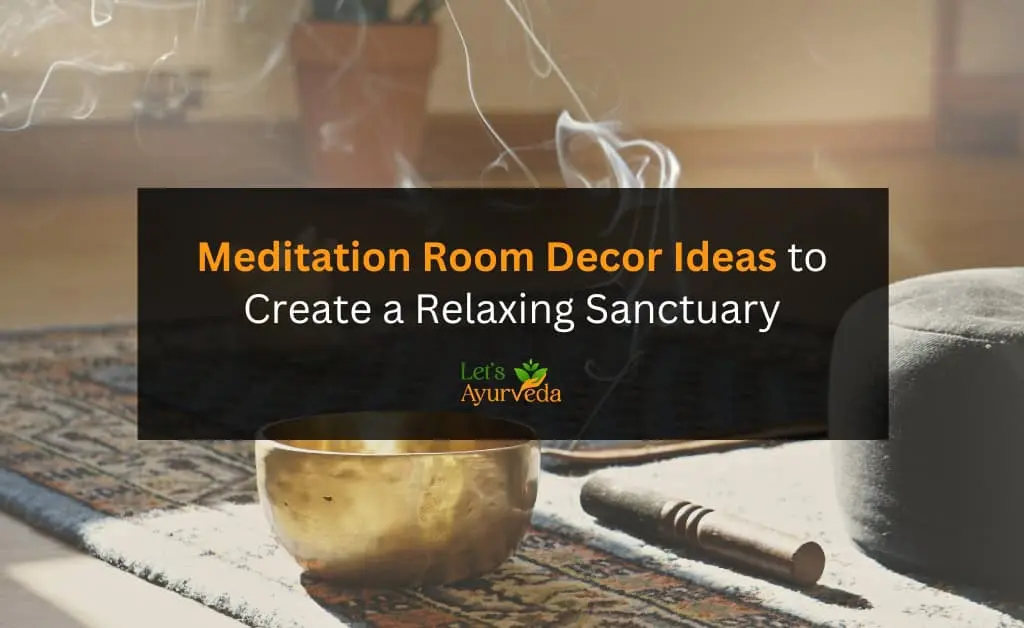Meditation is more than just sitting in silence; it’s about creating an environment that fosters relaxation, focus, and peace. And what better place than a designated meditation room in your home?
If you’re looking to transform a space into your own meditative sanctuary, this guide covers everything—from mindful colors and soothing lighting to the must-have items for an atmosphere that invites calm and clarity.
Meditation Room Decor Ideas
1. Choose Calming Colors for Inner Peace
The color of a room can influence your mood and ability to relax. Soft shades like pale blues, light grays, and earthy tones are ideal for a meditation space, helping your mind unwind. Research shows that blues and greens are linked to calmness and can lower stress levels, making these tones perfect for your sanctuary.
Quick Tip:
- Avoid overly bright colors or busy patterns that might distract you from focusing inward. Instead, stick with neutral or pastel shades that create a subtle, grounding effect.
2. Incorporate Natural Elements to Connect with the Earth
Nature has a grounding effect that can deepen your meditation practice. Bring in plants like snake plants, peace lilies, or small succulents for a natural vibe. Plants not only add a touch of greenery but also purify the air, providing a healthier environment. Studies reveal that houseplants can reduce stress and boost mood, creating a perfect meditation environment.
Quick Tip:
- Use natural wood furniture or bamboo decorations to enhance that earthy, natural feel.
3. Declutter and Organize for Mental Clarity
Clutter has a direct impact on your mental space, often creating tension and stress. A meditation room should be free of unnecessary items to allow you to fully let go. Consider a few minimal pieces, such as a meditation cushion, a small table, or a low bench, and organize items in a way that feels open and spacious.
Quick Tip:
- Keep storage to a minimum; a single cabinet or basket can help hide away any essentials, so your room maintains its peaceful atmosphere.
4. Select Comfortable and Supportive Seating
Comfort is key when you’re trying to meditate. Cushions, floor pillows, or a yoga mat can make the space inviting while allowing you to sit comfortably for longer periods. Some people prefer using meditation benches or chairs with back support if sitting on the floor isn’t an option.
Quick Tip:
- Test out a few seating options until you find what feels best for your body and meditation practice.
5. Optimize Lighting for a Soothing Atmosphere
Lighting can make or break your meditation experience. Soft, warm lights are often best for creating a calming ambiance. Consider adding dimmable lamps or candles for evening meditations, or use natural light for a fresh, uplifting feeling during the day.
Quick Tip:
- Avoid harsh overhead lights; instead, add floor or table lamps that create a softer glow.
6. Bring in Fragrance for a Sensory Experience
Scents play a powerful role in relaxation. Essential oils, incense, or natural candles can transform your room into a sensory retreat. Scents like lavender, sandalwood, or chamomile are known for their calming properties, while eucalyptus can be refreshing and grounding.
Quick Tip:
- Use an essential oil diffuser or light an incense stick before you start your meditation session to set the mood.
7. Integrate Sounds to Elevate the Meditation Experience
Adding soothing sounds like white noise, gentle chimes, or soft meditation music can enhance your practice by masking any disruptive background noises. Studies have shown that specific types of music, like ambient sounds or nature noises, can help lower blood pressure and reduce anxiety.
Quick Tip:
- A small Bluetooth speaker or a white noise machine can work wonders in transforming your space into a tranquil escape.
8. Create a Focal Point to Deepen Focus
A focal point in your meditation room, such as a small altar, a crystal, or a tapestry, helps set an intention and deepens your practice. This could be as simple as a single object on a table that represents peace or personal growth, giving your mind something to settle on when it wanders.
Quick Tip:
- Choose objects that hold personal significance, as they can make your meditation space feel more meaningful and inviting.
9. Ensure Adequate Ventilation for Freshness
Fresh air is crucial for a clear mind. A stuffy room can make you feel tired or irritable, which isn’t ideal for meditation. If possible, open a window or use a fan to circulate the air before you meditate, ensuring your space is light and fresh.
Quick Tip:
- If outdoor air quality is a concern, consider an air purifier with a HEPA filter to keep the air clean and fresh.
10. Personalize Your Space for an Authentic Connection
Your meditation room should reflect your personal journey and goals. Add items like books on mindfulness, a journal for jotting down reflections, or inspirational quotes on the wall. These items make the space feel uniquely yours, reminding you of your commitment to your practice.
Quick Tip:
- Keep personalization minimal to avoid clutter but make sure it feels genuine and connected to your goals.
Bonus: Meditation Room Layout Ideas
Here are a few layout ideas based on different room sizes to help you get started:
-
Small Space Solution: Use a corner of a room or a closet space. Place a cushion or small mat with a plant or small altar for a cozy yet functional meditation area.
-
Medium-Sized Room: Add a low table, cushions, and some floor pillows. Consider wall-mounted shelving for items like candles, crystals, or incense holders.
-
Large Room: You can experiment with more elements, like a small indoor fountain, a floor-to-ceiling tapestry, and a reading nook for mindfulness books.
Key Takeaways for Creating Your Meditation Room
Creating a meditation room doesn’t require a massive budget or a complete room renovation. Here’s a quick summary of the essentials to make this transformation effective:
- Use neutral and calming colors for walls.
- Bring in natural elements like plants and wood accents.
- Keep the space organized and clutter-free for mental clarity.
- Choose comfortable seating that suits your posture and preference.
- Set up soft, adjustable lighting for a soothing atmosphere.
- Add pleasant scents and sounds for a sensory experience.
- Create a focal point to deepen your focus.
- Ensure good ventilation for fresh air circulation.
- Personalize the space in small, meaningful ways.
Final Thoughts: Start Small and Grow Your Space
Remember, creating the perfect meditation room is a journey, just like meditation itself. Start with a few key items that make you feel calm and grounded. Over time, you can add elements that resonate with your practice and personalize the room further. Whether it’s a cozy corner in your living room or a whole room dedicated to your practice, what matters most is how the space makes you feel.
By following these simple decor ideas, you can create a meditation room that not only looks serene but also invites you to unwind, focus, and feel at peace each time you step inside.






